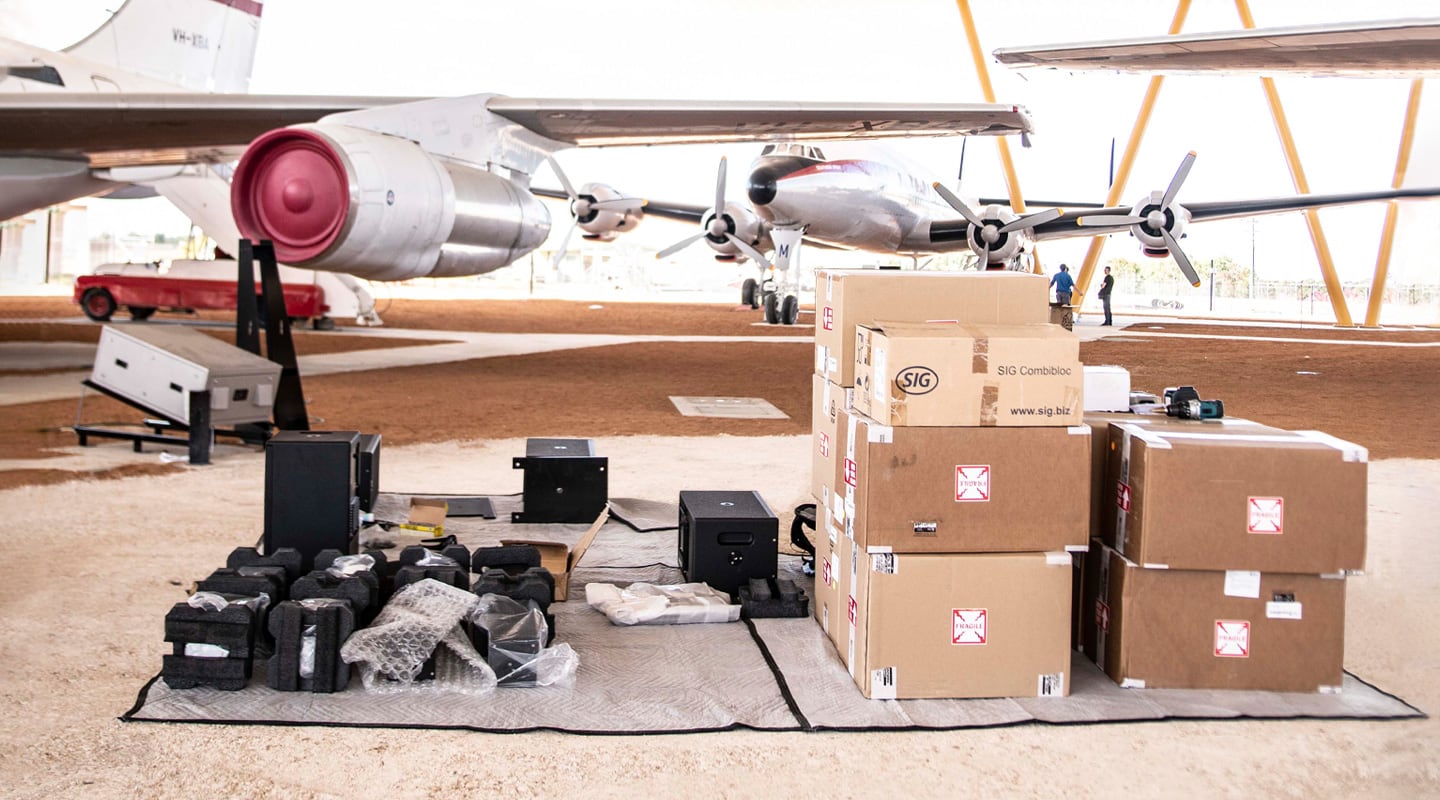
QF101: Immersive Audio in a Hangar
Qantas Founders Museum’s new sound + light show highlights an incredible Meyer immersive audio system. Sound designer, Josh Wilkinson, explains how he produced the soundtrack.
Qantas turns 100 this year. The reason why there aren’t 100 choirboys singing Peter Allen showstoppers on your front lawn is, of course, Covid. The planned celebrations have been iced until things blow over.
The centenary did give extra impetus to another project ‘down the road’ in Longreach, at the Qantas Founders Museum. The museum secured funding for an amazing light and sound show in its upgraded, architecturally-designed main airpark. The show combines some top-draw storytelling with state-of-the-art projection mapping, lighting and, of real interest here, immersive audio.
TAKING A HANGAR
The stars of the show are the four aircraft housed under the huge roof of the airpark. In order of age there’s the: Douglas DC3, Lockheed Super Constellation, Boeing 707 and the 747.
The museum trust approached the Buchan Group in Brisbane to realise some kind of film exhibit to go into the airpark.
Buchan isn’t a traditional museum exhibit producer, they’re a renaissance design house, happy to throw their expertise at any visual/built challenge.
Buchan Senior Associate, Anthony Rawson and Senior Designer, Pat Shirley, suggested radical approach to the presentation: ‘why don’t we use the planes themselves as projection canvasses?’
The resulting 25-minute film reinvigorates archival footage and brings the old birds to life… in no small part thanks to some inspired immersive sound design by Josh Wilkinson.
IMMERSIVE AUDIO
The show’s audience area fills an elliptical space in among the four aircraft. Buchan quickly determined that the show would best be enjoyed when the audience are on their feet. The show is brief enough to not be fatiguing for most people and it means the young and the short of stature can move about to be guaranteed of good sightlines.
But to truly immerse the audience, the show needed a truly immersive audio system.
Buchan asked Design Stage to lead the audio design and procurement, while Josh Wilkinson took care of the sound design.
“The brief was for a 360° surround sound system that encompassed the audience viewing area, as well as overhead speakers for special effects as well as general public address duties,” reports Design Stage boss, Phil Viney.
After investigating a number of premium loudspeakers Phil Viney and the team decided on Meyer Sound.
“One of the key reasons behind the decision is the Meyer’s use of low-voltage power. Meyer pioneered the use of powered loudspeakers in live sound. A Meyer PA would use one cable to run power and audio. But rather than running 240V cabling plus audio, which can give you some segregation issues and interference, they came up with a system where they run a 48V DC power rail and balanced audio down the same cable.”
The furthest pair of Meyer UPJuniors are 50m from the listening position!


Meyer’s MPS-488HP IntelligentDC Speaker PSUs provide 48V DC power and full range signal down a single cable, which addresses any safety concerns by running low voltage cables in public areas — an issue Phil Viney was alive to.
Some eight speaker positions mark the perimeter of the viewing area, comprising a Meyer UP-4XP full-range loudspeaker and a MM-10XP sub. The two loudspeakers are housed in a custom-designed tailfin-like chassis.
Overhead, Phil Viney spec’ed four pairs of Meyer Sound UPJuniors. “They sound huge during the flyover effects,” observes Phil Viney. “They’re an amazing-sounding loudspeaker.”
A pair of Meyer’s Galaxy processors provide all the DSP and matrixing. Meyer’s new Spacemap Go immersive mixing tool wasn’t quite ready in time for this project. Instead, Josh (the sound designer) and Dan (the control programmer) ‘baked in’ the audio aspects of the show. That said, the Galaxy processors are only a firmware upgrade away from being ready to use with Spacemap Go on a show.
“The design allows for the use of the new Milan AVB protocol,” explains Phil Viney. “It’s early days, and the MOTU AVB interface isn’t quite on the same page as the Milan version of AVB, so the show is currently using analogue lines but that will change. The MOTU 16A interface provides 16 additional inputs into the system which we’ve made available on a patchbay. It’s designed for visiting crew to use their own audio mixer.”

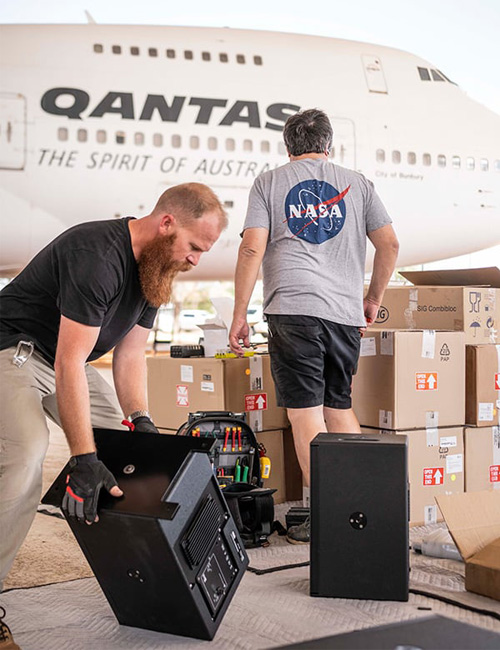
MORE ON THE SOUND DESIGN
Josh Wilkinson reflects on the job of designing an arresting sound track in one of the world’s most unusual immersive audio arenas.
Josh Wilkinson: “From the onset Buchan made the soundtrack a priority. Which isn’t always the case and made the project a real pleasure.
“My brief was to create something that would really blow people away… that they wouldn’t expect.”
Josh built the tracks in Reaper, with an Ambisonic panning plug-in, mixing down key elements like the voiceover, aircraft sounds, music and ambience into subgroups.
But given the bespoke nature of the immersive audio setup, there was no way to have the mix ready for the space without being in the space. Josh spent a number of solitary nights sitting in the middle of the audience area mixing his work for the system.
“There was no substitute for being in the space. For example, the overhead speakers are a key element but they track the length of the roof span, which is 70m or so long. The furthest pair of Meyer UPJuniors are 50m from the listening position! It’s very hard to predict what a pan might sound like until you’re there hearing it. It turns out that you can let the natural delay do most of the work for you.”
The audio focus of the presentation changes when the projections move from the 747 to the other aircraft. In fact, it’s the panning of the voice over audio that shifts the audience focus as they turn and face the aircraft that’s the focus of the commentary.
Everyone on the project noted Josh’s talent and there’s little doubt this project is a feather in his cap.
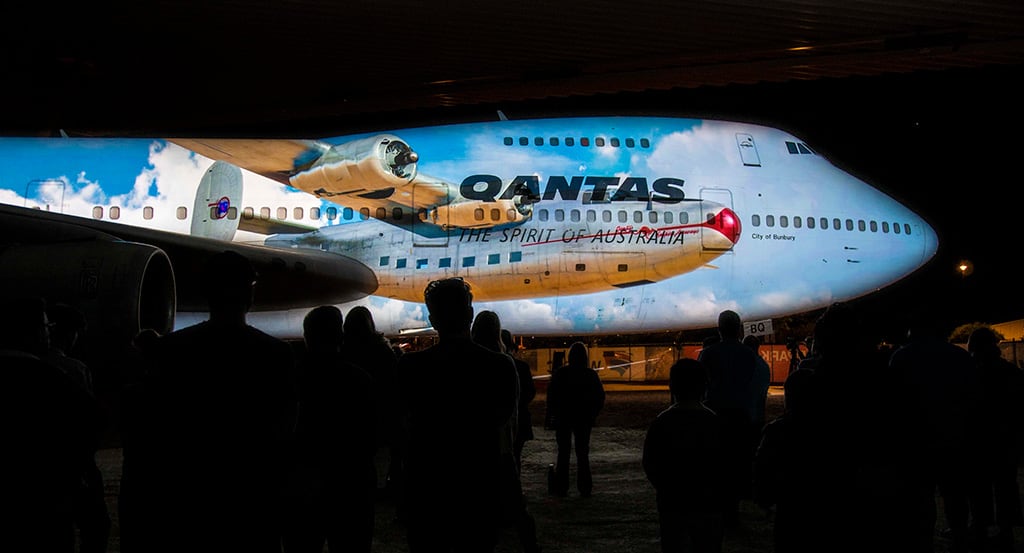




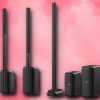


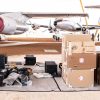

















RESPONSES